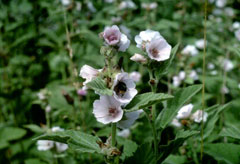
Marshmallow Plant
General Information:
Marshmallow (Althaea officinalis), also known as khatma and khatmi in the East, is a perennial plant of the Mallow family native to Eurasia. It’s characterized by pentamerous flowers that vary from white to pink as well as its grey-brown mucilaginous root used for many medicinal purposes. (Sometimes the bloom will have a pink center and the petals will have a pink to white gradation). Marshmallow also has hairy leaves with palmate venation. It grows to about four feet tall and two feet across in varying soil types, soil pH, and salinities; usually in ditches and grassy banks near the sea. However, it thrives in the sun with either dry or moist soil conditions.
The Marshmallow plant was named after the Greeks with the genus name Althaea coming from the Greek word “althos” meaning healer, which denotes the reverent nature the Greeks had for its healing capabilities; It was their “official healer.” The species name officinalis pertains to marshmallow as a medicinal plant since the word officinalis is associated with pharmaceuticals.
Although marshmallow has medicinal properties, it is also known as a confectionary since it was first made in the mid-nineteenth century by combining the root juices with egg whites and sugar. Modern marshmallow products actually do not have any derivatives from the marshmallow plant; animal gels and gums are used instead.
Traditional Uses:
Marshmallow was traditionally used for a plethora of common ailments by many different people. The Romans and Egyptians ate the plant daily as a vegetable and used it as a soothing agent for colds, coughs, and irritated skin. A Greek physician named Dioscorides recommended that marshmallow extracts be used for inflammation and healing wounds. In Syria, marshmallow was primarily eaten by the poor to keep starvation at bay. Later around the Renaissance period, it was also used to ease toothaches and intestinal problems. To address these issues, the root was often peeled, chewed, and/or eaten. The leaves and roots were also steeped and the mucilage would be used externally on the body.
Chemical Constituents:
Marshmallow contains high levels of antioxidants and flavonoids, “a group of polphenolic compounds,” which are mostly found in the flower. Marshmallow plants having white flowers had higher levels of flavonoids than those with pink flowers when analyzed for relative flavonoid content (Sadighara et al). The marshmallow root also has “5–11% of water-soluble polysaccharides including galacturorhamnans, arabinans, glucans and arabinogalactans [9–15]. Phenolic acids, tannins, flavone glycosides, the coumarin scopoletin, starch and pectin are other chemical constituents” found in the root (Ghavi).
Current Research and Uses:
Research was done to analyze the effect of aqueous marshmallow root extract on mucous membranes in accordance with its traditional use to alleviate common ailments. In this study, epithelial cells were exposed to aqueous root extract in vivo, and the researchers found that root extract “[stimulated] active effects on epithelial cells and passive mucilaginous” and had “barrier-enhancing effects on connective tissue cells” (Deters et al). This means that marshmallow root extract aids in repairing damaged mucous membranes in the body.
Another study focuses on the root extract’s ability to “modulate chemically induced cough reflex as well as mechanisms of polysaccharide’s cough-suppressive activity” in guinea pigs (Sutovská, M et al). Guinea pigs with citric acid-induced cough were given water containing marshmallow root extract and were then observed (Sutovská, M et al). Researchers concluded that “Althaea rhamnogalacturonan dose-dependently decreases number of citric acid-induced cough in guinea pigs” in alliance with traditional uses to treat respiratory diseases (Sutovská, M et al).
Sources:
Deters, J. Zippel, N. Hellenbrand, D. Pappai, C. Possemeyer, A. Hensel. “Aqueous extracts and polysaccharides from Marshmallow roots (Althea officinalis L.): Cellular internalisation and stimulation of cell physiology of human epithelial cells in vitro.” J. Ethnopharmacol., 127 (2010), pp. 62-69. PubMed. https://www-sciencedirect-com.ezproxy.stthomas.edu/science/article/pii/S0378874109006102
Ghavi, Peyman Pakrokh. “The extraction process optimization of antioxidant polysaccharides from Marshmallow (Althaea officinalis L.) roots.” International Journal of Biological Macromolecules, vol. 75, pp. 51-57. ScienceDirect. https://www-sciencedirect-com.ezproxy.stthomas.edu/science/article/pii/S0141813015000239#bib0235.
“Marshmallow: Althaea Officinalis.” Marshmallow: Althaea Officinalis | The Medicinal Herb Gardens at ONU, webstu.onu.edu/garden/node/361.
“Marshmallow, Althaea Officinalis.” Herbal Encyclopedia, 17 May 2016, http://www.cloverleaffarmherbs.com/marshmallow/.
“marshmallow.” The American Heritage Dictionary of Medicine, edited by Editors of the American Heritage Dictionaries, Houghton Mifflin, 2nd edition, 2015. Credo Reference, http://ezproxy.stthomas.edu/login?qurl=https%3A%2F%2Fsearch.credoreference.com%2Fcontent%2Fentry%2Fhmmedicaldict%2Fmarshmallow%2F0%3FinstitutionId%3D696. Accessed 24 Apr. 2018.
“Marshmallow.” Marshmallow (Marshmallow – Althaea Officinalis L.) – Medicinal Plants – Kooperation Phytopharmaka, http://www.koop-phyto.org/en/medicinal-plants/marshmallow.php.
Pfaf Plant Search, http://www.pfaf.org/user/plant.aspx?LatinName=Althaea%2Bofficinalis.
Rhodes, Jesse. “It’s a Marshmallow World.” Smithsonian.com, Smithsonian Institution, 12 Jan. 2011, http://www.smithsonianmag.com/arts-culture/its-a-marshmallow-world-27466036/.
Sadighara, Parisa et al. “The Antioxidant and Flavonoids Contents of Althaea Officinalis L. Flowers Based on Their Color.” Avicenna Journal of Phytomedicine 2.3 (2012): 113–117. Print.
Sutovská, M, et al. “Possible Mechanisms of Dose-Dependent Cough Suppressive Effect of Althaea Officinalis Rhamnogalacturonan in Guinea Pigs Test System.” International Journal of Biological Macromolecules., vol. 45, no. 1, pp. 27–32.
Photo Sources:
“Tips Curing Disease.” Benefits Of Marshmallow (Althaea Officinalis) For Health, http://www.tipdisease.com/2014/11/benefits-of-marshmallow-althaea.html.
https://shop.tranceplants.net/products/marshmallow-roots.
This page was created by Erin Mahre.



